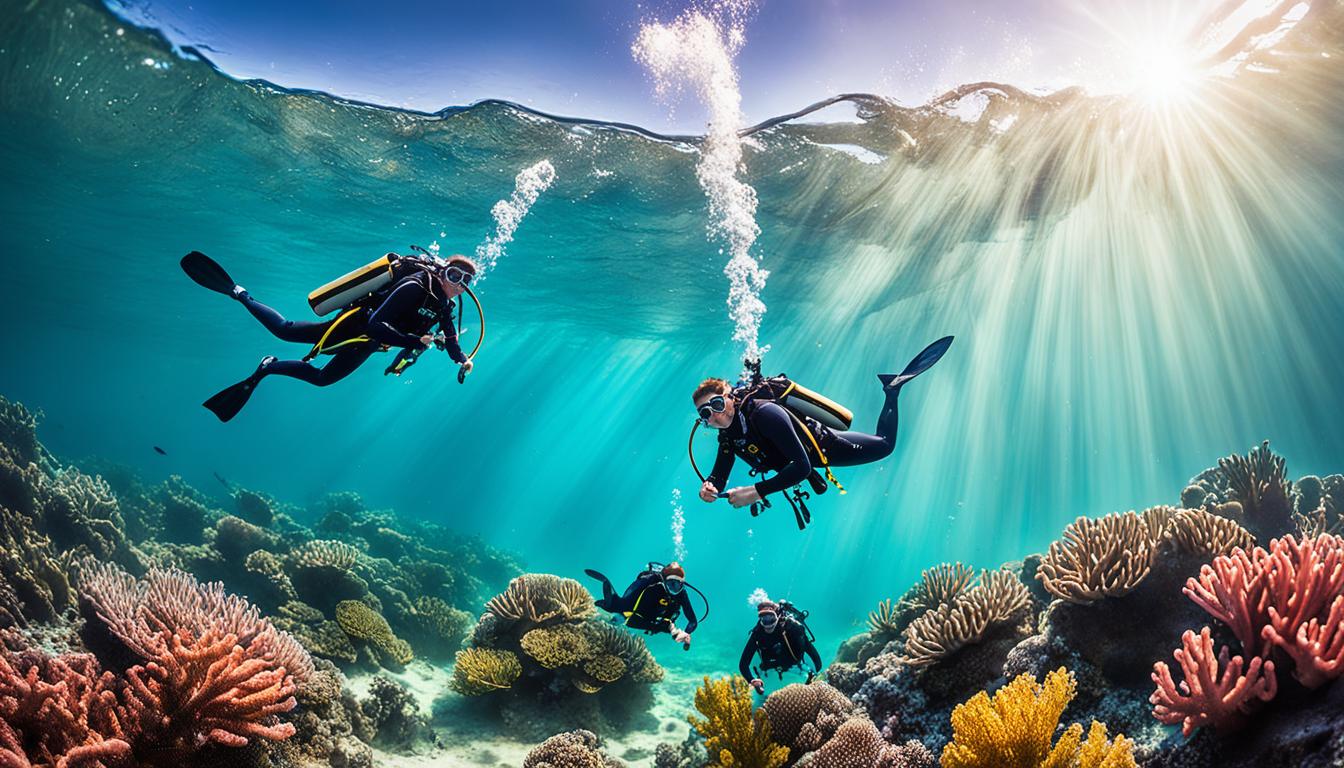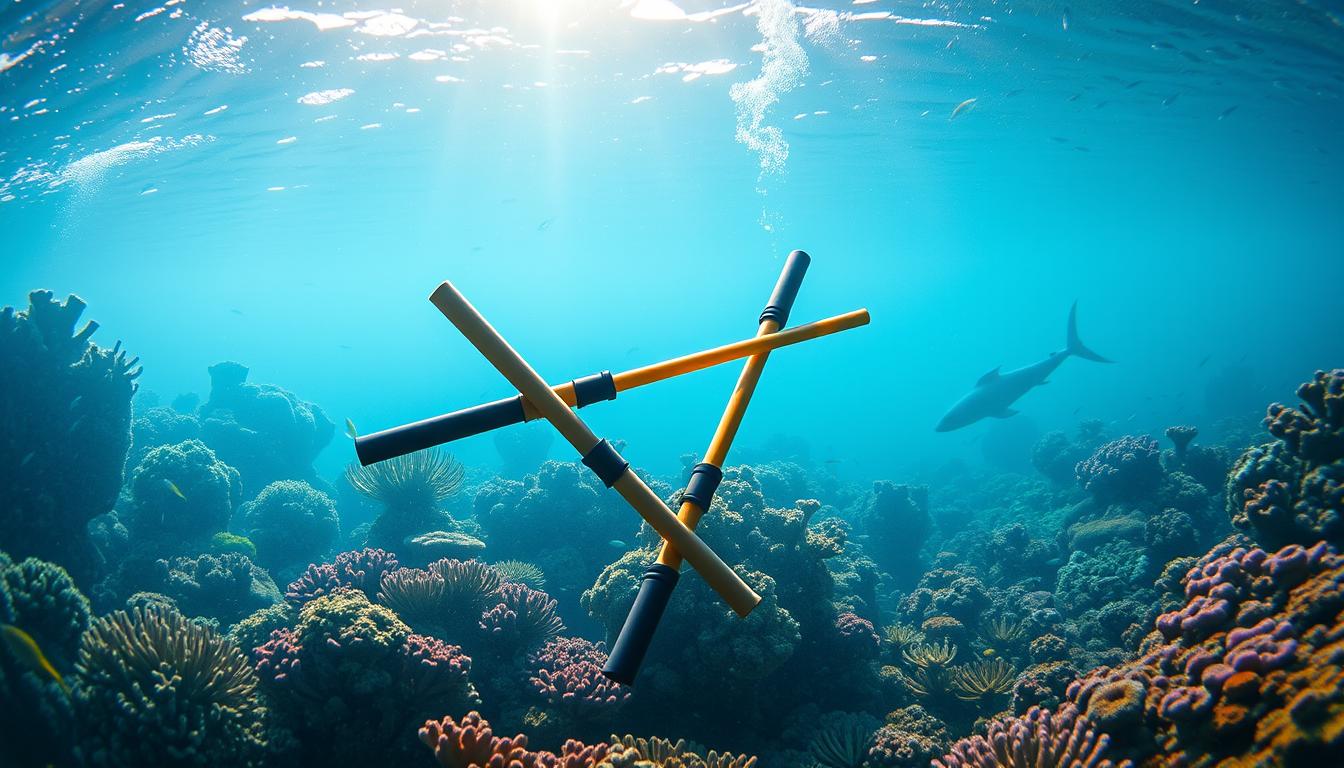Imagine diving into the crystal-clear waters of Queensland, feeling the rush of adrenaline as you navigate the depths in search of the perfect catch. Spearfishing is the ultimate sport for thrill seekers, combining the excitement of underwater exploration with the skill and precision of fishing.
In recent years, spearfishing has soared in popularity, thanks in part to adventurers sharing their incredible underwater experiences on social media. Spearfishers like Zachary Schmidt, with over 150,000 followers, have inspired a new generation of enthusiasts to take up this exhilarating sport.
But spearfishing isn’t just about the thrill. It’s also about the connection with nature and the underwater world. Queensland’s diverse marine ecosystem offers an abundance of species, from Snappers and Breams to Coral Trout and Parrotfish. As you explore the stunning reefs, offshore islands, and shipwrecks, you’ll encounter a vibrant underwater world that will leave you in awe.
However, it’s important to approach spearfishing with caution. The waters of Queensland are home to magnificent creatures like Great White Sharks and Grey Nurse Sharks, so it’s crucial to respect protected species and their habitats. Safety is paramount, too, with the occasional shark encounter a reminder of the risks involved. Remember to always have a dive buddy and be aware of personal limits.
Regulations play a significant role in ensuring the sustainability of spearfishing in Queensland. Adhering to catch limits, using diving flags, and maintaining equipment in good condition are crucial for preserving the delicate balance of the marine environment. Research also suggests that targeted conservation efforts and joining spearfishing clubs contribute to the sport’s long-term viability.
So, whether you’re a seasoned spearfisher or a beginner eager to try something new, Queensland offers a wealth of spearfishing opportunities that will leave you breathless. Grab your gear, dive into the adventures that await, and discover the captivating world beneath the surface.
Key Takeaways:
- Queensland is a haven for spearfishing, with its warm waters and diverse marine ecosystem.
- Respect protected species and their habitats, such as Great White Sharks and Grey Nurse Sharks.
- Always prioritize safety by diving with a trusted buddy and understanding personal limits.
- Adhere to regulations, including catch limits, the use of diving flags, and maintaining equipment.
- Joining spearfishing clubs and supporting conservation efforts contribute to the sport’s sustainability.
Top Spearfishing Spots in Western Australia
When it comes to spearfishing in Queensland, there are a few spots that stand out as must-visit destinations. One such location is Exmouth in Western Australia. Not only is this place blessed with stunning natural beauty, but it also offers fantastic spearfishing opportunities.
Exmouth is considered one of the best spearfishing spots in Western Australia for several reasons. The fishing regulations allow spearfishing from the shore in most areas, giving you easy access to the underwater world. This means that you can explore the vibrant marine life without the need for a boat.
What makes Exmouth truly special are the diverse target species that you can encounter. From Mangrove Jack and Trevally to Mackerel, Parrotfish, and more, there is plenty to keep even the most seasoned spearos excited. The abundance of fish and the challenging underwater terrain offer a thrilling adventure for both beginners and experienced divers.
It’s important to note that while exploring the waters of Exmouth, safety should always be a top priority. Shark encounters are a possibility, especially during the turtle breeding season. To mitigate risks, it is recommended to use a shark shield when spearfishing in this area. The shark shield creates a powerful electromagnetic field, deterring sharks and providing peace of mind during your underwater explorations.
So, if you’re ready for an unforgettable spearfishing experience, make sure to add Exmouth in Western Australia to your bucket list. With its stunning underwater landscapes and a variety of target species, this destination promises to create memories that will last a lifetime. Whether you’re a seasoned spearfisher or a beginner looking to try something new, the crystal-clear waters and abundant marine life make Exmouth an ideal spot for all skill levels. The thrill of encountering everything from coral trout to pelagic species will have you coming back for more. An Exmouth spearfishing experience is truly one for the adventurer’s soul—guaranteed to leave you breathless with every dive.
For more information about spearfishing in Queensland or to discover other top spearfishing spots, stay tuned for upcoming sections of this article. Happy spearfishing!
| Spearfishing Spot | Target Species |
|---|---|
| Exmouth, Western Australia | Mangrove Jack, Trevally, Mackerel, Parrotfish, and more |
Spearfishing Adventures in Northern Territory
Discover the thrill of spearfishing in the pristine waters of the Northern Territory. With its diverse marine ecosystem and abundant fish species, this region is a paradise for experienced spearfishermen. From the bustling city of Darwin to the remote coastal areas, spearfishing enthusiasts can embark on exciting adventures to catch some of the most sought-after fish in this part of Australia.
Spearfishing in the Northern Territory offers a unique and thrilling experience. As one of the oldest forms of angling worldwide, spearfishing holds historical significance and allows you to connect with ancient fishing techniques passed down through generations.
When spearfishing in the Northern Territory, it is crucial to possess strong swimming skills, be comfortable with snorkeling and free diving techniques, and have a good eye and steady hand. These essential skills will enhance your chances of success and ensure a safe and enjoyable spearfishing trip.
While the Northern Territory offers exceptional spearfishing opportunities, it’s important to note that estuaries and creeks are not recommended due to the presence of saltwater crocodiles. Therefore, sticking to populated areas and well-established spearfishing locations is advised for your safety.
Getting to these spearfishing locations is made easy with the availability of boat trips and charters. These common modes of transport open up a world of possibilities as you explore different fishing grounds and target various species.

One charter company that specializes in spearfishing adventures in the Northern Territory is Reel Deep Charters. They offer spearfishing charters onboard their custom-built charter boat, the Westcoaster. This vessel, measuring 72ft in length, is purpose-built for fishing and spearfishing excursions, ensuring a comfortable and well-equipped experience.
| Spearfishing Charter Details | Reel Deep Charters |
|---|---|
| Vessel | The Westcoaster (72ft) |
| Capacity | Up to 10 passengers |
| Duration | Minimum 4 days |
| Amenities | Air-conditioned accommodation, modern galley, outdoor entertainment decks |
| Equipment | Fully equipped for fishing and spearfishing adventures |
With their extensive knowledge of the local waters, the team at Reel Deep Charters will guide you to the best spearfishing locations in the Northern Territory, ensuring a memorable and rewarding experience.
While the Northern Territory offers incredible spearfishing opportunities, the Great Barrier Reef, located nearby, boasts the most diverse species of fish globally. Combining a spearfishing adventure in the Northern Territory with an extended charter to the Great Barrier Reef will provide the ultimate fishing experience in a pristine marine wilderness.
Whether you’re a seasoned spearfisherman or a beginner looking to dive into the world of spearfishing, the Northern Territory offers unforgettable adventures. Immerse yourself in the rich marine environment, reel in sustainable and delicious fish, and create memories that will last a lifetime.
Enjoy Spearfishing in South Australia
If you’re looking to indulge in the exhilarating sport of spearfishing, South Australia offers incredible opportunities, especially around Adelaide. With over 35 years of experience in spearfishing, Name has explored the best spots in the region, providing a wealth of knowledge and expertise.
One must-visit location for spearfishing enthusiasts in South Australia is Gull Rock. This renowned spot offers a diverse range of marine life, making it an ideal destination for underwater adventure. As you dive into the crystal-clear waters, you’ll have the chance to encounter Australian Salmon, Abalone, Crayfish, Rock Cod, Snook, and more. The abundance of species and the underwater scenery will leave you spellbound.
For those interested in networking and gaining valuable insights, joining spearfishing clubs in Queensland is a great way to connect with like-minded individuals. These clubs foster a sense of community and offer a platform for sharing experiences, tips, and techniques. Spearfishing clubs in Queensland, such as the Queensland Spearfishing Club, also organize regular outings and competitions, providing opportunities for camaraderie and friendly competition.
Membership in Spearfishing Clubs QLD
By becoming a member of spearfishing clubs in Queensland, you can enjoy various benefits:
- Access to exclusive information on the best spearfishing locations in Queensland
- Invitations to club-organized spearfishing trips and excursions
- Opportunities to learn from experienced spearfishers and improve your skills
- Participation in friendly competitions
- Chance to contribute to spearfishing conservation initiatives and sustainable fisheries
Whether you’re a beginner or a seasoned spearfisher, joining a spearfishing club in Queensland will enhance your spearfishing journey and provide you with a supportive community passionate about the sport.
South Australia’s Must-See Spearfishing Species
| Species | Description | Location |
|---|---|---|
| Bluefin Tuna | Can reach well over 100 kilograms in weight, sighted during summer in Victoria, South Australia & Tasmania, and off the New South Wales coast in winter. | Coastal waters of South Australia |
| Wahoo | Can grow up to 2.5 meters in length and weigh as much as 83 kilograms, often caught near Brisbane around North Stradbroke and Moreton Island and in the Southern Great Barrier Reef. | Near Brisbane, North Stradbroke Island, Moreton Island, Southern Great Barrier Reef |
| Yellowtail Kingfish | Can reach up to 2.5 meters in length and 30 kilograms in weight, mainly found in coastal waters and bays off the east, south, and west coasts of Australia. | Coastal waters and bays off the east, south, and west coasts of Australia |
| Spanish Mackerel | Can grow over 50 kilograms, reach swim speeds of 5.5 meters per second, and are located in northern Australian waters on both East and West coasts during the Summer and Autumn months. | Northern Australian waters on both East and West coasts |
Exploring South Australia’s abundant marine life while spearfishing is an unforgettable adventure. Whether you’re captivated by the vibrant colors of the Great Barrier Reef or drawn to the diverse fish species that inhabit South Australia’s coastal waters, spearfishing in this region is a testament to the beauty and thrill of the sport.
Remember to adhere to local regulations and guidelines outlined in the handbooks produced by the Local Fisheries departments. Additionally, Australia’s leading spearfishing governing body has received a government grant to develop the Safe Spearfishing Initiative Program. This program includes a DVD, brochure, and stickers to promote safe practices and raise awareness about the conservation of marine resources.
Immerse yourself in the world of spearfishing in South Australia and create unforgettable memories in the pristine waters of this magnificent region.

Queensland Spearfishing Charters and Tours
When it comes to spearfishing adventures in Australia, Queensland is a top destination that offers incredible opportunities to explore the underwater world and target a variety of fish species. With its warm waters and diverse marine life, the state attracts spearfishing enthusiasts from all over the world.
If you’re looking for an unforgettable spearfishing experience in Queensland, consider booking a charter or tour. One such option is the Whitsundays Spearfishing Charter, a 5-day, 4-night tour departing from Airlie Beach. Priced at $2000.00 per ticket, this charter offers an action-packed adventure aboard an 82ft ex-racing maxi yacht.
During the charter, you’ll have the opportunity to explore the stunning reefs that are 35-50 nm from the Marina in Airlie Beach. The itinerary includes full-day spearing broken up into two sessions for 3 days, targeting a range of fish species including Coral Trout, Tusk Fish, various types of Emperors, Reef Jack, Purple Spot Cod, Job Fish, Crayfish, Trevally, and Spanish Mackerel.
As part of the package, all meals and accommodations are included, ensuring a comfortable and enjoyable experience. The maximum capacity of the tour is 14 guests, allowing for ample space and a personalized experience. The boat is equipped with experienced crew members, USB charging stations, and diving weights.
Guests are required to bring their own gear, including a float and float line, reef/bluewater gun, backup gun, mask, snorkel, fins, knives, wetsuit, flasher, fish storage bags, sunscreen, insect repellent, and other necessary items. It is important to come prepared to make the most out of your spearfishing adventure.
The Whitsundays Spearfishing Charter departs and returns to Coral Sea Marina in Airlie Beach, with a return time of approximately 3:30 pm on the 5th day. Car parking options are available at Coral Sea Marina South Village for $10.00 per day. While no official check-in is required, guests must complete waivers at least 7 days in advance.
The charter is highly recommended, with an average rating of 4.9 based on 131 reviews for Prosail Whitsundays. It offers an incredible opportunity to explore the Queensland waters and target over 30 species of fish. Whether you’re a seasoned spearfisher or a beginner, this charter provides a thrilling and educational experience.
For bookings and inquiries, it is best to visit the official Prosail website and get in touch with their team. They will provide specific details and assist you in planning an unforgettable spearfishing adventure in the beautiful waters of Queensland.

| Charter Details: | Whitsundays Spearfishing Charter |
|---|---|
| Duration: | 5 days, 4 nights |
| Price: | $2000.00 per ticket |
| Boat: | 82ft ex-racing maxi yacht |
| Target Fish Species: | Coral Trout, Tusk Fish, Emperors, Reef Jack, Purple Spot Cod, Job Fish, Crayfish, Trevally, Spanish Mackerel |
| Inclusions: | All meals, experienced crew, accommodation, diving weights, spearfishing ribs with boat boys, USB charging stations |
| Capacity: | Maximum of 14 guests |
| Departure Location: | Coral Sea Marina, Airlie Beach |
| Return Time: | Approximately 3:30 pm on the 5th day |
| Reviews: | Average rating of 4.9 based on 131 reviews |
Dive into the Thrills of Spearfishing in New South Wales
When it comes to spearfishing, New South Wales is a treasure trove of opportunities. With 75 top spearfishing locales waiting to be discovered, this coastal state offers a diverse range of experiences for both local enthusiasts and visitors alike.
One of the standout spots in New South Wales is Eden, a picturesque destination known for its abundance of marine life and ideal spearfishing conditions. As you explore the waters of Eden, you’ll encounter an array of species, including Bream, Luderick, Leatherjacket, and Ling. And while the waters may be cooler compared to other regions, a thicker wetsuit will ensure your comfort as you embark on your spearfishing adventure.
For those seeking even more thrills, Sydney’s Northern Beaches and South Coast offer excellent spearfishing locations. Immerse yourself in these beautiful coastal areas and discover the excitement of hunting Snapper, Kingfish, and other prized species.
If you’re new to spearfishing or looking to enhance your skills, New South Wales welcomes beginners with open arms. The cool waters of the state provide an ideal environment for learning the ropes and honing your spearfishing techniques. Take advantage of the numerous spearfishing clubs and online forums available to connect with experienced spearfishers who can offer guidance and share their expertise.
To make the most of your spearfishing adventure in New South Wales, be sure to equip yourself with the right gear. From wetsuits and snorkels to spearguns and dive masks, having reliable and quality spearfishing gear will enhance your safety and enjoyment. Find specialized spearfishing gear retailers across the state or explore online options to ensure you’re well-prepared for your underwater endeavors.

As you embark on your spearfishing journey in New South Wales, remember to respect the rules and regulations in place. Spearfishing is not allowed in coastal lagoons, estuaries, marine parks, or within aquatic reserves. It’s important to protect the marine ecosystem and preserve the delicate balance of underwater life.
So, pack your gear, dive into the crystal-clear waters of New South Wales, and experience the exhilaration of spearfishing amidst stunning coastal landscapes. With its diverse range of spearfishing locations and welcoming community of enthusiasts, New South Wales is truly a spearfishing paradise.
Challenging Spearfishing in Victoria
While Victoria may have some of the coldest waters in Australia, it also offers great opportunities for spearfishing enthusiasts. With its diverse marine habitats and abundance of fish species, Victoria is a challenging and rewarding destination for spearfishing.
One of the top spearfishing locations in Victoria is Port Phillip Bay, known for its excellent shore-diving spots. Whether you’re a beginner or an experienced spearfisherman, the bay offers a range of sites suitable for all skill levels.
It’s important to stay updated on spearfishing regulations in Victoria to ensure compliance. Unlike most other states, the use of compressed air, such as scuba gear, is legal while spearfishing in Victoria. This provides divers with the opportunity to explore deeper waters and target a wider range of fish species.
Victoria is considered relatively safe and effective for catching fresh fish through spearfishing. Spearfishing clubs, like Southern Freedivers in Melbourne, are great resources for practical information, organizing competitions, and connecting with fellow spearfishing enthusiasts.
To engage in spearfishing in Victoria, basic equipment such as a mask, snorkel, fins, spearfishing dive knife, gloves, Hawaiian sling or spear gun, and a divers float with an alpha flag and tow rope is essential. Additionally, divers must adhere to local regulations that prohibit spear guns or hand-held spears in certain marine areas.
Prior to spearfishing in Victoria, it is necessary to obtain a current fishing license. This can be conveniently secured online or from various recreational fishing license outlets.
When engaging in spearfishing, safety precautions should always be a priority. Diving with a buddy, staying within comfortable depths, and being aware of ocean conditions and dive sites are crucial. Following safety procedures, such as not tethering speared fish to the body and utilizing a dive flag, is essential for the well-being of divers.
To assist spearfishing enthusiasts in finding suitable locations, the Melbourne Spearfishing Sites web page provides a comprehensive database of over 350 dive sites. This resource helps divers choose appropriate locations based on their skill level and preferences.
While Victoria may present its own set of challenges, it offers a unique and thrilling spearfishing experience. Whether you’re a beginner or an advanced spearfisherman, Victoria’s waters are waiting to be explored.

Essential Tips for a Successful Spearfishing Trip
When planning your spearfishing trip in Queensland, there are a few important factors to consider that will help ensure a successful and enjoyable experience. From choosing the right gear to staying safe in the water, these tips will help you make the most of your spearfishing adventure.
1. Wear Appropriate Gear
Investing in high-quality spearfishing gear is essential for a successful trip. In Queensland, where water temperatures can vary, it’s crucial to wear the appropriate wetsuit thickness for the conditions. This will keep you comfortable and protected, allowing you to focus on your spearfishing skills.
2. Avoid Tethering Your Catch
When spearfishing in Queensland, it’s important to reduce the risk of attracting sharks. One way to do this is to avoid tethering your catch to your body. Instead, use a float line or a stringer to keep your fish separate from you. This will help minimize any shark encounters and ensure your safety in the water.
3. Stay Informed
Stay updated with local spearfishing regulations in Queensland, as they may vary depending on the location and species you are targeting. Additionally, always check the weather and currents before heading out. This information will help you plan your dive and ensure a safe and successful experience.
4. Carry Essential Safety Equipment
Carrying essential safety equipment is crucial for any spearfishing trip. Always have a dive knife strapped securely to your body. This tool will come in handy in case you need to cut yourself free from any entanglements underwater. Additionally, consider using a shark shield for added protection against potential shark encounters.
5. Embrace Freediving
Freediving is the preferred method for spearfishing in Queensland. Unlike scuba diving, which is only allowed in Western Australia, freediving allows you to connect more intimately with the marine environment. It also provides a greater challenge and a deeper sense of accomplishment as you explore the depths.
By following these essential tips, you’ll be well-prepared for a successful spearfishing trip in Queensland. Remember to always prioritize safety, stay informed about regulations, and enjoy the thrill of this popular recreational activity.

| Statistics | Insights |
|---|---|
| Spearfishing First Timers | Consider not using a gun initially to observe and learn, then take a shot when comfortable. |
| Shore Dive Entry and Exits | Thoroughly plan entry and exit points, as they may vary in suitability. |
| Equipment for Shore Diving | Should be robust and simple, including a hard float for visibility and support, and a fully equipped first aid kit. |
| Spearfishing as a Popular Recreational Activity | Engaged by a significant number of enthusiasts globally. |
| Growing Popularity of Spearfishing | Especially among coastal regions and water sports enthusiasts. |
| Sales Analysis of Spearfishing Equipment | Indicates a growing market for spearguns, snorkels, fins, and other gear. |
| Sustainability and Environmental Conservation | Many spearfishers emphasize these aspects in their approach to the activity. |
| Rise in Spearfishing Communities and Clubs | Signaling a trend towards social engagement and knowledge sharing. |
| Shore Diving as a Common Starting Point | Due to accessibility and abundance of marine life near coastal areas. |
| Boat Ownership and Spearfishing | Correlation found between boat ownership and pursuit of spearfishing in remote or offshore locations. |
| Popularity of Breath-Hold Spearfishing | Enthusiasts favor the challenge and connection it provides with marine life. |
| Growing Interest in Sustainable Practices | Focus on responsible fishing and environmental stewardship within the community. |
| Emerging Spearfishing Tourism | Development of travel experiences tailored to spearfishing enthusiasts. |
Best Time to Go Spearfishing in QLD
When planning your spearfishing adventures in Queensland, it’s essential to consider the best time to maximize your chances of success. The coastal waters of Queensland offer a diverse range of fish species and breathtaking underwater landscapes. To ensure a memorable and fruitful experience, timing is key.
The optimal seasons for spearfishing in Queensland are spring and summer, spanning from November to April. During these months, the warm weather and favorable water conditions create the perfect environment for spearfishing enthusiasts. The increased water temperatures attract a wide variety of fish species, making it an ideal time to explore the underwater world.
Spring and summer provide an abundance of pelagic species, including Jewfish, Mangrove Jacks, and Spanish Mackerel, particularly in South East Queensland, home to the bustling cities of Brisbane and the Gold Coast. These cities serve as popular spearfishing hubs, offering ample opportunities to dive into the depths and encounter your target species.
For those venturing further north, North Queensland presents exciting spearfishing prospects in regions such as Mackay and Cairns. Here, you can target iconic species like Barramundi, Fingermark, and Mangrove Jack. It’s important to note that while spearfishing from the shore in North Queensland, spearos should exercise caution as there may be stingers, sharks, and crocodiles in the area.
Central Queensland, encompassing destinations like Bundaberg, 1770/Agnes Waters, Gladstone, and Yeppoon, offers unique opportunities to target Coral Trout, Parrot Fish, and Spanish Mackerel. Exploring these regions during the recommended seasons ensures optimal conditions and a higher chance of encountering your desired catch.
Compliance with spearfishing regulations specific to each area is crucial. Green zones and certain restrictions enforced by the Great Barrier Reef Marine Park Authority aim to protect the delicate marine ecosystem. Make sure to familiarize yourself with the rules and regulations applicable to your desired spearfishing location to ensure a responsible and enjoyable experience.

When planning your spearfishing trip in Queensland, it’s also important to consider the visibility and water temperature. Some locations, like Bundaberg, recommend using 3.5mm wetsuits during the winter months to enhance visibility in the water. Being prepared with appropriate gear will contribute to a successful and comfortable dive.
In summary, the best time to go spearfishing in Queensland is during the spring and summer months. This period offers favorable weather conditions, increased fish activity, and a wide range of species to target. Whether you’re exploring the vibrant waters of the Gold Coast, Brisbane, or venturing north to Mackay and Cairns, Queensland promises an unforgettable spearfishing experience.
Conclusion
Spearfishing in Queensland, known for its abundant marine life and vibrant underwater ecosystems, offers both thrilling adventures and a commitment to sustainable fishing practices. Despite concerns about the impact of spearfishing on reef fish populations, scientific research has shown that spearfishers catch less than one percent of the fish caught annually compared to recreational and commercial fishers.
While there has been a 54% reduction in the density of coral trout and a 27% reduction in their mean size three years after spearfishing was allowed in the Conservation Park Zones (CPZ) within the Great Barrier Reef Marine Park, spearfishing has been found to be more selective than line fishing. This selectivity leads to fewer undersized, undesirable, or protected fish being captured, promoting the long-term sustainability of Queensland’s marine ecosystems.
Queensland spearfishing enthusiasts can explore a range of destinations, including the Palm Archipelago and the Coral Sea, famous for its diverse species like Dogtooth tuna and pelagic fish. As the recreational fishing industry in Australia continues to thrive, spearfishing plays a significant role, attracting both locals and international visitors to experience the thrill and beauty of underwater spearfishing adventures.
Despite weather constraints and ongoing debates about activity limitations in certain areas, spearfishing in Queensland remains a popular and exciting sport. By following regulations and guidelines, spearfishers can enjoy memorable experiences while ensuring the preservation of the marine environment, contributing to the sustainable growth of this thriving recreational pursuit.










